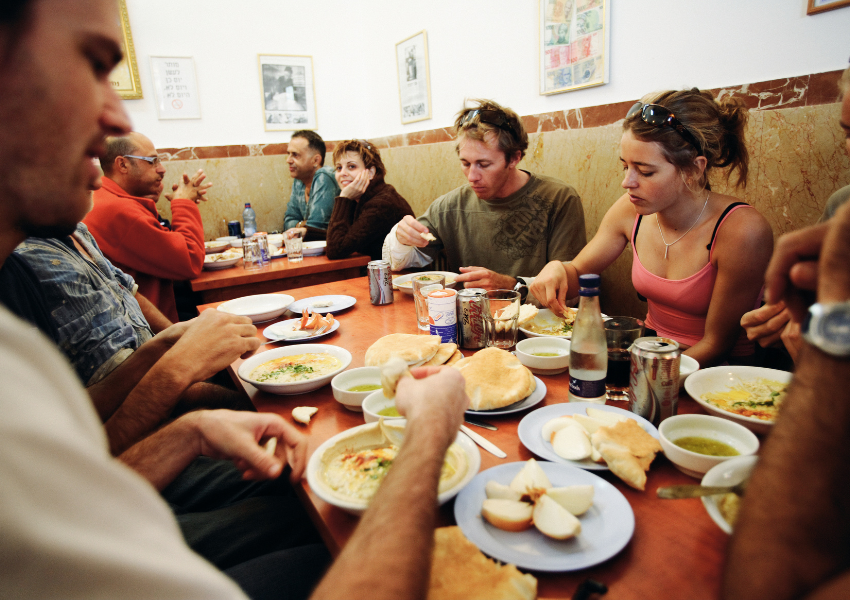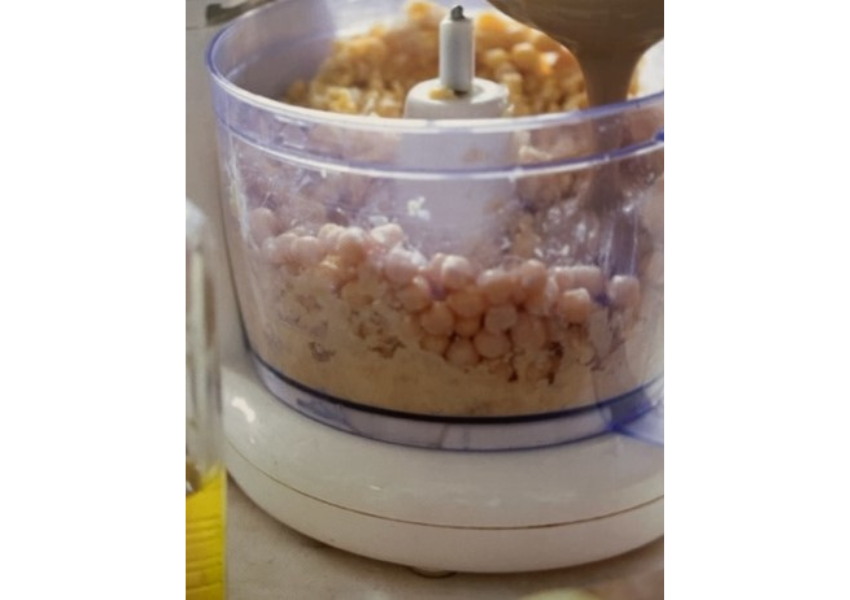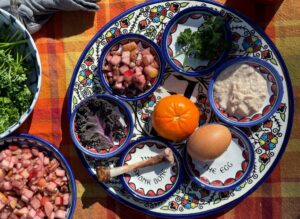Everything You Need To Know About Hummus (and How To Make It)
Dive into hummus history, controversy, and etiquette
By Janna Gur
Published Dec 5, 2022

In the Levant, hummus is touted as “the king of meze”, but in the Israeli food culture, it is even more than the centerpiece of the Middle Eastern smorgasbord. For Israelis, hummus is a religion of sorts – adored by everyone: worthy of going out just to lenagev (“mop up” to use local parlance) a plate of this creamy concoction, a subject of numerous blogs and books and a source of heated debates regarding comparative virtues of various hummus “temples”, proper ways to make it, and more.
In the Levant, hummus is touted as “the king of meze”, but in the Israeli food culture, it is even more than the centerpiece of the Middle Eastern smorgasbord. For Israelis, hummus is a religion of sorts – adored by everyone: worthy of going out just to lenagev (“mop up” to use local parlance) a plate of this creamy concoction, a subject of numerous blogs and books and a source of heated debates regarding comparative virtues of various hummus “temples”, proper ways to make it, and more.

COURTESY EILON PAZ
So, we already established that hummus has spread beyond the Levant, but can the product found on the shelf of your local deli or supermarket be considered the real deal? According to hummus aficionados, the answer is “no”.
Real hummus is freshly made, and consumed within 24 hours of its preparation. Real hummus doesn’t contain any chemicals intended to make it shelf-stable (which rules out all supermarket varieties). Real hummus is made of cooked chickpeas, tahini, lemon, salt, perhaps a bit of garlic or a sprinkle of cumin. That’s it! Garlic confit, roasted tomatoes, spinach or, God forbid, chocolate don’t belong in the real hummus plate.
To experience hummus in all its chickpea glory, Israelis head to a hummusiah – a small eatery, often no more than a hole in the wall, swimming in the aroma of cooking chickpeas.
Some joints are considered national treasures, worthy of a special trip, though numerous “secret” neighborhood spots are just as good. One of the attributes of a proper hummusiah is the fact that freshly made hummus is the only offering. You can choose between hummus gargirim (topped with cooked chickpeas), hummus ful (topped with fava beans stew) or, my favourite, mesabbahah (aka mashaushe) – cooked chickpeas, slightly mashed and mixed with warm, spiced tahini sauce. You can ask for a hardboiled egg, to make your hummus meal even more filling.
Some hummus joints might treat you with freshly fried crunchy falafel balls, which go so well with all this creamy goodness. Mandatory trimmings include roughly cut veggies (tomatoes, radishes, onions), pickles, cracked bitter Suri olives and a basket of soft pita bread. Eating hummus with a fork or carrot sticks is for the weaklings and calorie-counters. A true hummus buff mops up his hummus with gusto and a thick slab of pita.

COURTESY DAN LEV
This might come as a surprise, but in the Middle East, Israel included, hummus is rarely made at home. Preparation is lengthy and the shelf life is very short, so we tend to outsource our hummus from a good hummusiah, which is usually just a short drive away. Since this might not be the situation in most places around the world, it is worth mastering the simple art of hummus making. You will need dry chickpeas (look for smaller varieties) and the best tahini you can find (my favorite brands are Al Arz and Har Bracha, both available on Amazon). Everything else you already have in your kitchen.
The following recipe is from The Galilee Table, the book I co-authored with a wonderful Galilean chef Yousef (Zuzu) Hanna. It yields a lot of hummus, so unless you are cooking for a crowd, half the amounts given here, or (even better) soak and cook lots of chickpeas and freeze them in small batches (along with a bit of the cooking liquid) in ziplock bags.
Ingredients (Serves 10-12):
2 cups dry chickpeas (preferably small)
½ teaspoon baking soda
1 cup best quality raw tahini
1 to 2 teaspoons salt
½ cup freshly squeezed lemon juice
For Serving:
Extra virgin aromatic olive oil
Finely chopped parsley
Toasted pine nuts (optional)
A dash of ground cumin (optional)
Directions:
- Put the chickpeas in a large bowl, add water to cover by 2 inches, and let soak for 24 hours at room temperature. Drain the soaked chickpeas in a colander and rinse thoroughly under running water.
- Transfer to a large pot, add fresh cold water to cover the chickpeas by 2 inches, add the baking soda, and bring to a rapid boil. Reduce the heat to low and simmer, continuously skimming the foam that forms on the surface. If the pot contents look dry, add more water. Cook until the chickpeas are completely soft, which should take about an hour and a half.
- Once the chickpeas reach the desired consistency, drain them but reserve one cup of the cooking liquid. If you plan to serve your hummus garnished with whole chickpeas, put aside a cup of them as well.
- If you intend to serve it right away, cool the chickpeas slightly to just above room temperature and move on to the next step. If you are going to serve the hummus later, even just a few hours later, put the chickpeas in the fridge and let them cool completely; it will prolong their shelf life and prevent spoilage.
- Put the cooked chickpeas in a large bowl and add ¾ cup of the tahini and ⅓ cup of the lemon juice, one heaping teaspoon of salt, a few ice cubes, and ⅔ cup of the cooking liquid. Mix everything together and let the mixture sit on the counter for about half an hour. This will deepen the flavor and improve the texture.
- Transfer the mixture to a food processor and puree until smooth. Stop the motor, taste, and see if you would like to add more tahini, lemon juice, salt or cooking liquid.
- To serve: Transfer the hummus to a large platter or individual plates (allow 2 to 3 heaping tablespoons per person) and swirl around the edges of the plate, creating a crater in the center. Warm the whole chickpeas you put aside earlier for garnish (microwaving is the most convenient) and spoon them into the crater. Drizzle with olive oil, sprinkle with chopped parsley and toasted pine nuts, dust with just a bit of cumin and serve.
Hungry for more?
Get the scoop on the history of eating hummus.
Explore On the Hummus Route –an award-winning treasure trove of history, trivia, philosophy, recipes, and mind-blowing photos celebrating hummus and other chickpea-based Middle Eastern dishes.
Janna Gur is a Tel Aviv-based cookbook author, journalist, speaker, and culinary expert.
Reflections
For everyone:
Do you think Hummus could be considered a local Israeli dish?
For Americans:
Can you think about an American dish that has a similar cult status?
The best-of-the-best
Have you ever experienced a proper hummus at a specialized restaurant? Is it really so different from whatever you find in a deli/supermarket?
New
Want more?
Get curated JewishArts.org content in your inbox





